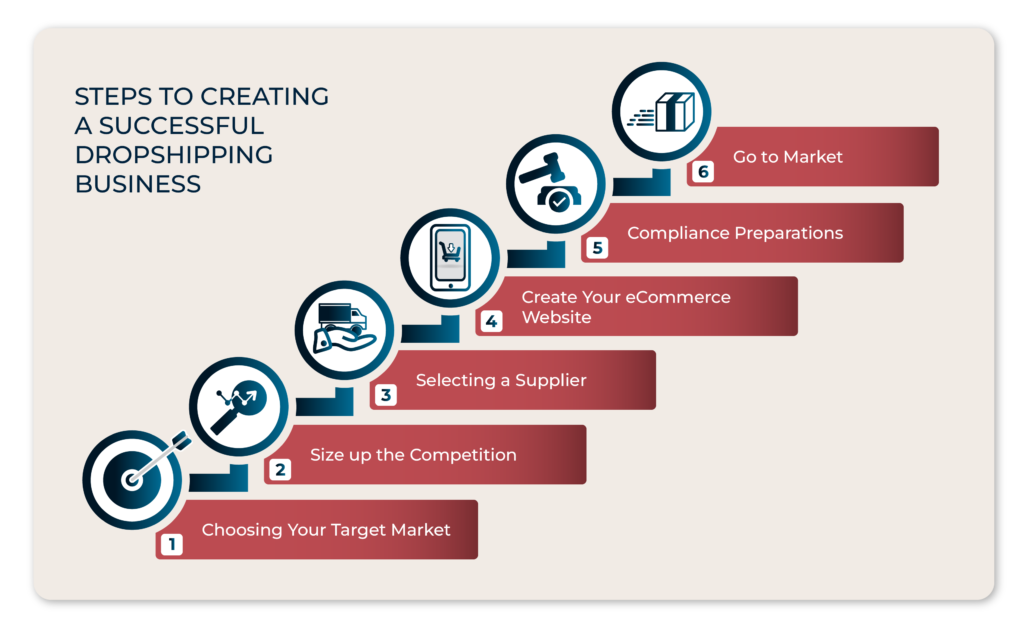With our increasing reliance on eCommerce to meet ever-growing global demand, dropshipping has seen a surge in popularity in recent years. Most online retailers can leverage dropshipping to fuel sales— and there are some basic steps that your business can take to get a solid start at dropshipping your products. Let’s dive in.
What is Dropshipping?
Dropshipping is an order fulfillment method that involves selling products without keeping physical inventory on hand. Instead, you work with a third-party company to manage all aspects of supplying, storing, fulfilling, and distributing products on behalf of your business. The advantages of this setup are clear–as a business owner, you can get up and running with relatively low startup costs, without needing to worry about the capital expenditure of storage or the logistics of shipping, handling, and returns.
How Does Dropshipping Work?
The dropshipping method is a business strategy that relies on a company (the dropshipper) listing products on an eCommerce site at some markup. The method involves three actors: the dropshipper, the supplier, and the customer.
Customer: The end-user who purchases the product from a seller’s (the dropshipper’s) website.
Dropshipper: (That’s you!) The intermediary between the supplier and the customer. The dropshipper is responsible for marketing and promoting the products on its website and connecting orders to a supplier to ship out. The dropshipper does not hold any inventory and does not have to worry about the shipping or handling of the products being sold.
Supplier: The company, often a wholesaler or manufacturer, is responsible for producing, storing, and shipping the products to the customer. They play a crucial role in ensuring the product quality and timely delivery.
To start a dropshipping business, the drop shipper needs to establish a relationship with a supplier and create an eCommerce website. When a customer purchases a product, the drop shipper sends the order to the supplier, which then fulfills and ships the product to the customer. The dropshipper makes a profit from the markup (the difference) between the cost paid to the supplier and the price the customer purchased the product for.
Pros of Dropshipping
Low Capital and Overhead
Starting a business requires a lot of capital. But with dropshipping, a business avoids having to store and provide logistics operations itself. In addition, rather than buying large quantities of inventory in bulk, it is purchased as needed to fill orders. This creates a much lower barrier to entry, allowing a company to start an online retail operation with little-to-no risk and minimized costs.
Easy Order Management
Without the need to hold and manage inventory, there isn’t a need to rent out warehouse space, hire staff, or physically handle shipments. This not only simplifies things from an operations perspective, but it also allows a company to sell products from anywhere in the world and rely on local distribution partners to get goods to purchasers.
Quickly Scale a Business and Handle Seasonality
Because inventory is purchased as needed, a business can meet demand as business takes off, or meet fluctuations more seamlessly. The supplier will manage the manufacturing aspects of the business while the dropshipper focuses on driving demand and creating satisfied customers.
Disadvantages of Dropshipping
Ok, if it’s so great then why isn’t everyone dropshipping? Dropshipping has its challenges–like any other strategy–and it’s up to each business owner to decide whether this approach will work best for their market’s needs. Here are some of the issues faced by drop shippers.
Lack of Control
A significant drawback of the dropshipping model is the lack of control over many aspects of the supply chain. For one, there is often no way to directly see the products as they are manufactured and distributed, so your third-party supplier must be heavily relied on to quality control the products they produce. This lack of control extends to fulfillment and delivery of the product and can result in parts of an order being forgotten. The resulting bad reviews can seriously impact sales, so finding a strong supplier for a partner is a must.
Inventory Issues
Because you don’t hold physical inventory, it can be difficult to know how much stock is ultimately available at a given time. While a strong partner can turn this into an advantage by helping you forecast order volume and maintain stock, problems can quickly escalate during periods of high order volume if communication breaks down. Long wait times for orders will lead to lower sales.
Less Brand Impact
If you are leveraging a third party to create a generic product, it can be hard for consumers to differentiate your goods from your competitors. This can make it difficult for your brand to stand out in an increasingly crowded field of dropshipping businesses. Because the supplier also provides all packaging for products going out the door, it may also be difficult to include any branding in your packaging materials.
Steps to Creating a Successful Dropshipping Business
If you’re ready to start a dropshipping business, you’ll want to carefully plan to make sure you are set up to be competitive and win. No industry is exactly the same, but following these guiding principles will help prepare your business for success.

Step One – Choosing Your Target Market
Start by researching the niche you want to fill. The dropshipping market is crowded and becoming more competitive by the day, so you should choose a product that has high demand and (relatively) low competition. Less competition means more opportunity for profit margin. And if it’s a product you will enjoy marketing, that’s an extra bonus. Some successful industries that drop shippers tend to like are fitness, tech, and jewelry.
There are many tools out there to help you uncover market demand, so be prepared to spend some time in this phase of your new dropshipping journey:
Google Trends: By using Google Trends, you are quickly able to enter a term to see a time graph, or trend, in searches for a product– allowing you to identify those that are trending upward in popularity. However, keep in mind this tool only shows relative interest in topics (on a scale of 0 to 100), not the actual volume of people interested, so it can be difficult to size the market opportunity with it alone.
Keyword Tools: To help complement Google Trends, you can use your choice of keyword tools. Websites like Semrush and Moz are popular search engine optimization (SEO) tools. These will allow you to see popular keywords with their monthly search volume and what different pages are already ranking for them. If you have set up a Google Ads account, you can use Google’s own free Keyword Planner tool, which is immensely helpful to better understand the average search volume and relative competitiveness of different search terms. Understanding trends in search terms for the product you want to sell will equip you with more information about your market size and the type of competition you’re up against, so it is an important part of the planning process.
Step Two – Size up the Competition
Once you’ve identified a product to dropship, it is important to conduct competitive research and get to know your target audience. Use social media to see the type of content your competitors use to engage their target audiences and drive business. Audit their websites to see how they position products and speak to site visitors. Browse the products on their eCommerce store. (If you’re somewhat tech-savvy, you can use developer tools to inspect their website and find out what platform and tools they are using for their site. If you’re not tech savvy, ask a friend who is.) You can also conduct competitor analysis through sites like Semrush and Moz to help better understand the content needed to perform in that space. Once you have a better understanding of the market you are competing in, you are ready to get down to business–this is where the real fun begins!
Step Three – Selecting a Supplier
One of the most important steps in the process of becoming a successful drop shipper is to find a good supplier to work with. You can leverage supplier databases like AliExpress or SaleHoo, or use an integrated supplier directory for your store’s back end, like DSers. Platforms like Shopify focus on nascent dropshipper entrepreneurs and can help streamline the setup process, so consider the options out there when selecting a partner. When deciding on a supplier to work with make sure to consider:
Product and Packaging Quality: Easily the most important factor is how your product will be arriving to your customers. Make sure to get tests from the supplier to quality test the product and make sure it is up to standards. Inspect the packaging to determine if it will be sufficient to protect the product as it makes its way to your customer.
Customer Service: Customers will inevitably have issues with orders, and you will want a supplier to help resolve issues that arise. Consider the supplier’s procedure for reverse logistics, which will be needed when a customer processes a return. It’s also important that your business has adequate support from your supplier.
Fulfillment Capabilities: You should understand how long the fulfillment process takes so that you can communicate delivery expectations to your customers. Don’t partner with a supplier before you can guarantee how long order delivery takes–from shopping cart payment to a customer’s doorstep.
Step Four – Create Your eCommerce Website
Before you can turn products into sales, you’ll need to set up a retail website where your customers can browse goods, add them to a cart, and send payments. Creating a website can be daunting, but many platforms exist today to help streamline the process and help you set up shop with little-to-no coding required.
Pick a Domain Name: Before you can create a website, you need to register a web address for your company. Make sure to choose a URL that will be easy to find and is memorable for customers.
Set up a Content Management System (CMS) or eCommerce Platform: You can use a CMS, like WordPress or Squarespace, to create your website (either from scratch or by using prefabricated templates and/or builders). Or, you can leverage an eCommerce platform, like Shopify, to register your domain, build your site, and list and sell products all in one.
Payment Gateway: Naturally, you want customers to be able to make purchases on your website, so you’ll need payment processing to handle the transaction. Stripe, PayPal, and Square are some of the most popular options for payments.
Step Five – Compliance Preparations
Before you begin selling your products it’s important to make sure you are following the regulations of the country you are in. Each location has different rules so you want to make sure you are adhering to them. This will help you avoid any issues related to operating a business. After researching the regulations in your area, you may consider setting up a business entity. Doing this will allow you to work better with your business partners and suppliers. Some of the most common business structures for small businesses include LLCs and sole proprietorships.
Sole Proprietorship: A sole proprietorship is an unincorporated business, allowing owners to avoid lots of additional paperwork. Most small businesses start out as a sole proprietorship before transitioning into something like an LLC.
Limited liability company (LLC): An LLC protects the owners from being pursued for the company’s debt and liabilities. This is why LLCs are so popular among small business owners.
It’s important for you to conduct proper research on business structures before choosing one. The U.S Small Business Administration (SBA) provides an in-depth business structure guide that may prove useful.
Step Six – Go to Market
Once everything is set up, you are ready to bring your product to the market–through marketing The marketing strategies you use will vary depending on market factors for your product and audience (which you should now be familiar with thanks to research and planning) . Here are some common marketing methods used in dropshipping.
Influencer Marketing: Leverage the huge popularity of apps like TikTok and Instagram to work with niche-specific influencers that will help promote your brand. This can get expensive quickly, so you may want to seek out influencers who will work as affiliates. This is basically a small kickback or commission, the influencer will get paid for helping sell the product.
Social Ads: Social media is a great channel to drive brand awareness and sales. 93.79% of businesses leverage social media in some way for marketing efforts. Social media platforms can serve highly-targeted ads to users who are in the market (already shopping around) for products similar to yours.
Search & Display Ads: Set up search and display ads on Google. 90% of the world conducts searches on Google, and Google Ads is essential to getting your business in front of new customers.
Email Marketing: As interested users begin engaging with your ads and your website, you can take advantage of email marketing to send them updates and prompt purchases with coupons or other offers. Use promo codes or special offers on your website to capture email addresses, which you can then use to nudge customers into a purchase. You can also use email to promote newly launched products (and so much more).




